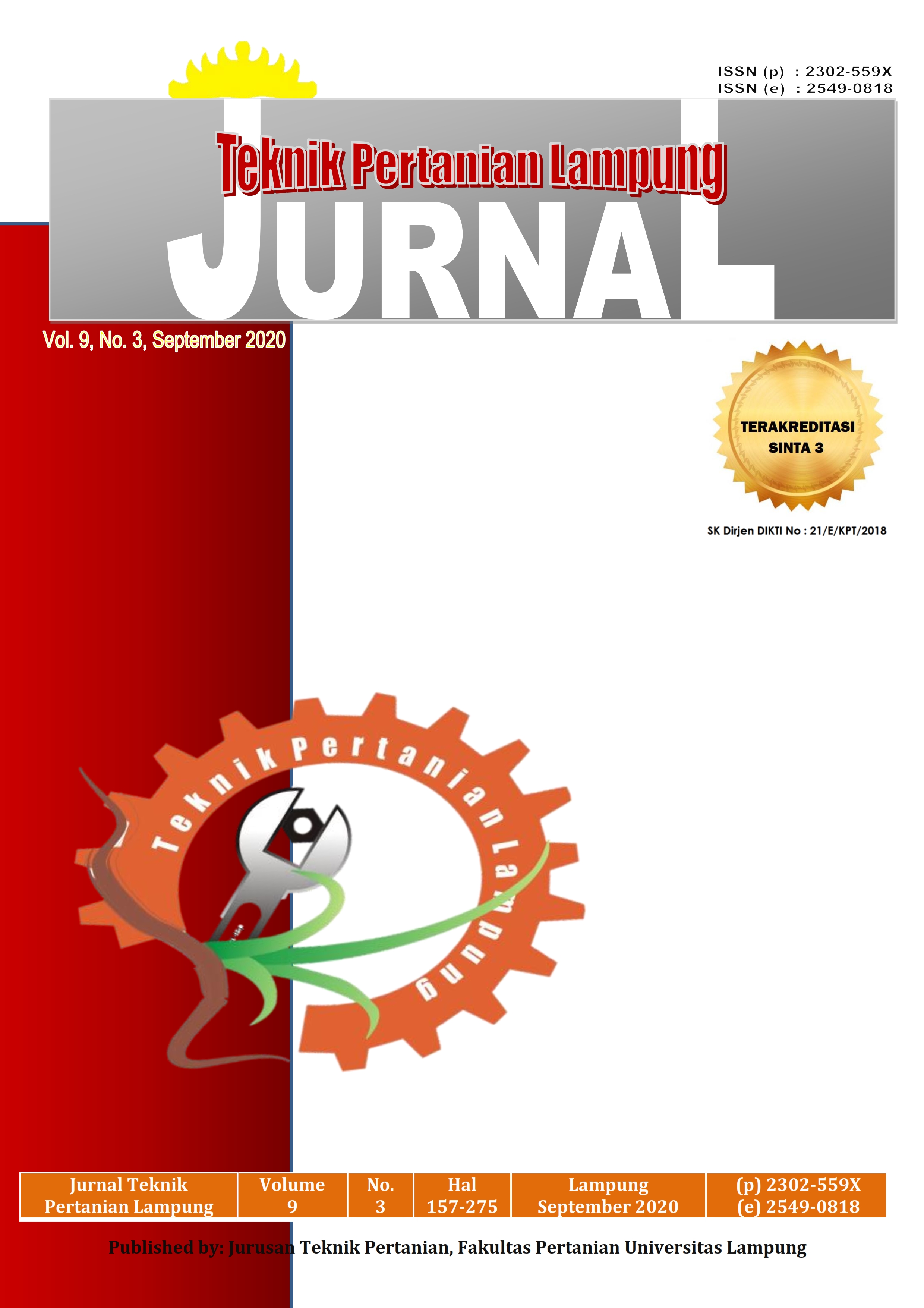TREN PERUBAHAN CROP WATER PRODUCTIVITY KAKAO (Theobroma cacao L. ) DI D.I. YOGYAKARTA
DOI:
https://doi.org/10.23960/jtep-l.v9i3.237-247Abstract
The studies on the Crop Water Productivity (CWP) of cocoa to increase productivity in the midst of water scarcity and climate change are currently underdeveloped. Thus, this study aims to find out the trends in climate, productivity, crop water use and CWP of cocoa plantations. The methods included collecting climate and productivity data during 2014-2019, simulating crop water use with Cropwat 8.0 software and analysing the changing trends of CWP in cocoa plantations, DI Yogyakarta. The results indicated the changes in productivity of cocoa plantation ranged from 0,41 − 0,53 tons / ha. The Crop Water Usage (CWU) decreased from 11.107 m3 in 2014 to 8.482 m3 in 2019 under rainfed schenario. Subsequently, the trend of CWP tended to increase from 0,037 kgm-3 in 2014 to 0,059 kgm-3 in 2019. CWP of cocoa plantation increased when CWU decreased and productivity increased. CWP value illustrated that every 1 m3 of water used have produced 0,037 − 0,059 kg of dried cocoa beans. In terms of water use efficiency, this relatively small CWP value indicates that the level of water use by cocoa plants in DI Yogyakarta is inefficient that requires improvement in the future such as increasing land productivity and precision irrigation schemes for cocoa plantations.
Keywords: Cacao (Theobroma cacao L.), crop water productivity, crop water use, D.I Yogyakarta
References
Allen, R. G., Pereira, L.S, Raes, D, dan Smith, M., eds. 1998. Crop Evapotranspiration: Guidelines for Computing Crop Water Requirements. FAO Irrigation and Drainage Paper 56. Rome: Food and Agriculture Organization of the United Nations.
Ayegboyin K.O., dan Akinrinde E.K. 2016. Effect of Water Deficit Imposed during the Early Developmental Phase on Photosynthesis of Cocoa (Theobroma cacao L.). Agricultural Sciences 7: 11-19. http://www.scirp.org/journal/as. http://dx.doi.org/10.4236/as.2016.71002
Boonwichai, Siriwat, Sangam Shrestha, Mukand S. Babel, Sutat Weesakul, dan Avishek Datta. 2018. Climate Change Impacts on Irrigation Water Requirement, Crop Water Productivity and Rice Yield in the Songkhram River Basin, Thailand. Journal of Cleaner Production 198 (October): 1157–64. https://doi.org/10.1016/j.jclepro.2018.07.146.
Carr, M. K. V., dan G. Lockwood. 2011. The Water Relations and Irrigation Requirements Of Cocoa (Theobroma Cacao L.): A Review. Experimental Agriculture 47 (4): 653–76. https://doi.org/10.1017/S0014479711000421.
Direktorat Jenderal Perkebunan Indonesia. 2018. Statistik Perkebunan Indonesia. Direktorat Jenderal Perkebunan Indonesia 1 (December 2014): 96.
Ercin, A. E., Mekonnen, M. M., dan Hoekstra, A. Y. 2013. Sustainability of national consumption from a water resources perspective: the case study for France. Ecological Economics 88: 133-147.
Ezenne, G.I., Louise Jupp, S.K. Mantel, dan J.L. Tanner. 2019. Current and Potential Capabilities of UAS for Crop Water Productivity in Precision Agriculture. Agricultural Water Management 218 (June): 158–64. https://doi.org/10.1016/j.agwat.2019.03.034.
Fitriana N, Tarumun S, Tetty E. 2014. Analisis Daya Saing Biji Kakao (Cocoa beans) di Pasar Internasional. Jom Faperta, 1(2).
Karmawati, Elna, Mahmud, Zainal, Syakir, M, et all. 2014. Budidaya Dan Pascapanen Kakao. Geomodel 2007 - 9th EAGE Science and Applied Research Conference on Oil and Gas Geological Exploration and Development: 3–4. https://doi.org/10.3997/2214-4609.201404137.
Kijne, J.W., Barker, R., Molden, D., 2003a. Water Productivity in Agriculture: Limits and Opportunities for Improvement. CAB International, Wallingford, UK.
Lahive, F., L. R. Handley, P. Hadley, and A. J. Daymond. 2018. The Impacts of Climate Change Variables on Vegetative and Reproductive Development of Six Genotypes of Cacao. International Symposium on Cocoa Research (ISCR), Lima, Peru, 13-17 November 2017. https://www.cabdirect.org/cabdirect/abstract/20203127119.
Marshall, M. T., K. P. Tu, P. Thenkabail, and J. F. Brown. 2016. Recent Decline in Crop Water Productivity in the United States: A Call to Grow More Crop per Drop. AGU Fall Meeting Abstracts 11 (December). http://adsabs.harvard.edu/abs/2016AGUFMPA11E..06M.
Najihah, Tuan Syaripah, Mohd Hafiz Ibrahim, Paul Hadley, and Andrew Daymond. 2018. The Effect of Different Day and Night Temperatures on the Growth and Physiology of Theobroma Cacao under Controlled Environment Condition. Annual Research & Review in Biology (June): 1–15. https://doi.org/10.9734/ARRB/2018/40413.
Ridoutt, B. G., & Pfister, S. 2010. A revised approach to water footprinting to make transparent the impacts of consumption and production on global freshwater scarcity. Global Environmental Change, 20(1): 113-120.
Sharma, Bharat, David Molden, and Simon Cook. 2015. Water Use Efficiency in Agriculture: Measurement, Current Situation and Trends. Managing Water and Fertilizer for Sustainable Agricultural Intensification: 39–64.
Sun, Shikun, ChengFeng Zhang, Xiaolei Li, Tianwa Zhou, Yubao Wang, Pute Wu, and Huanjie Cai. 2017. Sensitivity of Crop Water Productivity to the Variation of Agricultural and Climatic Factors: A Study of Hetao Irrigation District, China. Journal of Cleaner Production 142 (January): 2562–69. https://doi.org/10.1016/j.jclepro.2016.11.020.
Xu, Zhenci, Xiuzhi Chen, Susie Ruqun Wu, Mimi Gong, Yueyue Du, Jinyan Wang, Yunkai Li, and Jianguo Liu. 2019. Spatial-Temporal Assessment of Water Footprint, Water Scarcity and Crop Water Productivity in a Major Crop Production Region. Journal of Cleaner Production 224 (July): 375–83. https://doi.org/10.1016/j.jclepro.2019.03.108.
Zwart, Sander J., and Wim G.M. Bastiaanssen. 2004. Review of Measured Crop Water Productivity Values for Irrigated Wheat, Rice, Cotton and Maize. Agricultural Water Management 69 (2): 115–33. https://doi.org/10.1016/j.agwat.2004.04.007.
Downloads
Published
Issue
Section
License
- Authors who publish with this journal agree to the following terms:
- Authors retain copyright and grant the journal right of first publication with the work simultaneously licensed under a Creative Commons Attribution-ShareAlike 4.0 International Lice that allows others to share the work with an acknowledgement of the work's authorship and initial publication in this journal.
- Authors are able to enter into separate, additional contractual arrangements for the non-exclusive distribution of the journal's published version of the work (e.g., post it to an institutional repository or publish it in a book), with an acknowledgement of its initial publication in this journal.
- Authors are permitted and encouraged to post their work online (e.g., in institutional repositories or on their website) prior to and during the submission process, as it can lead to productive exchanges, as well as earlier and greater citation of published work (See The Effect of Open Access).
Jurnal Teknik Pertanian Lampung

JTEPL is licensed under a Creative Commons Attribution-ShareAlike 4.0 International License.

